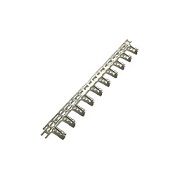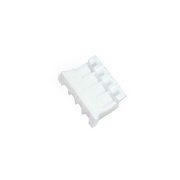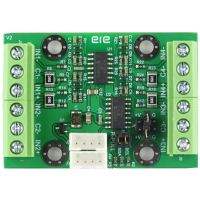*The RoHS icon on this product indicates that the PCBs, components, solder, and chemicals are all lead-free and RoHS compliant. Additionally, this product is produced using a lead-free process. Unfortunately, we are currently unable to provide documentation confirming that this product is RoHS compliant.
Resources:
*If your browser cannot display the PDF file properly, please save it to your computer and open it with a PDF reader.
Package Includes:
This package doesn't include cables.
Notes:
- This board uses 4-pin connectors for I2C bus.
Features:
- 4 channels of analog inputs
- Voltage on each input: 0-5V, 0-10V
- Current on each input: 0-20mA, 4-20mA, 0-40mA, 0-80mA
- 16-bit ADC, ADS1115
- I2C bus speed 100Khz, 400Khz, 3.4Mhz
- Pull-up resistors available on I2C lines
- Supports up to 4 boards on a single bus
- Single supply voltage: 2.7V to 5.5V for operation
- Inverse polarity protection for power supply
- Over-voltage protections for inputs
- Low-pass filter
- Programable digital filter
- Programable data rate
This is a compact I2C bus analog-to-digital converter board (I2C ADC board). Voltage and current sources can be connected to each input of the board. The board converts the analog values to digital values, which can then be processed by a microcontroller. The microcontroller can read the digital values through the I2C bus.
The compact I2C ADC board has four inputs. Each input accepts voltage in the ranges of 0-5V and 0-10V, and current in the ranges of 0-20mA, 4-20mA, 0-40mA, and 0-80mA. The resolution of the digital values is 16 bits, with the most significant bit (MSB) used as a sign bit.
The board requires only a single supply voltage ranging from 2.7V to 5.5V. The I2C bus clock speed is compatible with standard 100kHz, 400kHz, and 3.4MHz modes.
The I2C bus address is selected by jumpers, allowing the board to be configured to one of four addresses. This means up to four boards can be connected on a single bus. The board includes a pair of 10kΩ pull-up resistors for the I2C lines (SCL and SDA), which can be enabled or disabled using the jumpers.
To prevent damage to the board, do not plug or unplug I2C cables while the power supply is on. Always turn off the power supply before plugging or unplugging I2C cables on the board.











